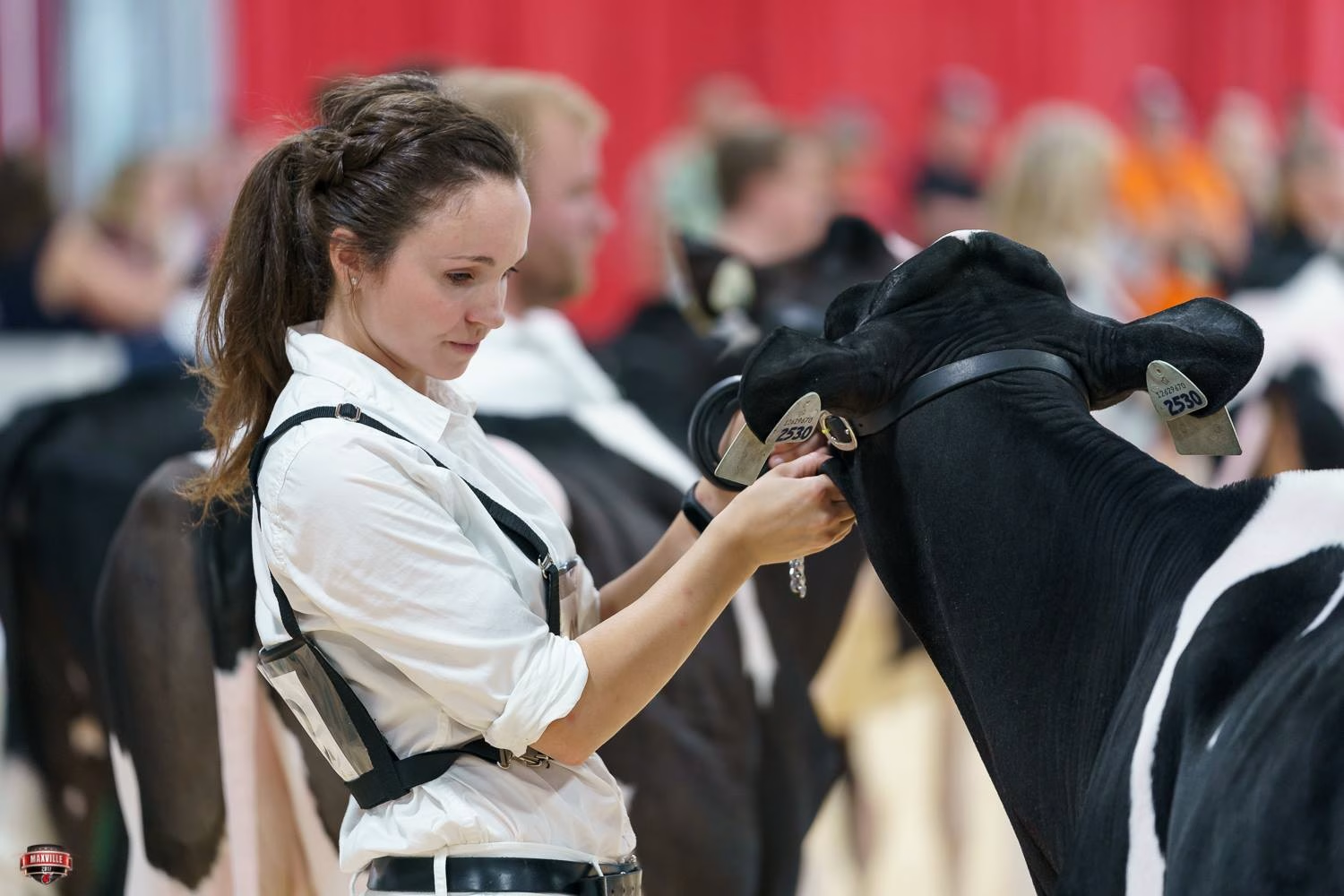Master dairy showmanship with essential PDCA guidelines. Are you ready to excel this fair season? Learn the rules to coach, compete, and judge effectively.

Are you going to shine this fair season? Learning dairy showmanship will set you apart from the competitors and create memorable memories. Whether your role is that of an enthusiastic exhibitor, loving parent, wise leader, seasoned instructor, or discriminating judge, a fair and consistent environment depends on knowing the PDCA Showmanship rules. Showmanship honors your abilities, expertise, and dedication more than it does your dairy animal presentation. The PDCA rules provide a consistent structure that guarantees equitable evaluation of every contestant. Thorough knowledge of the regulations will significantly affect coaching, learning, and judging when presenting dairy products!
The PDCA: Upholding Excellence and Fairness in Dairy Showmanship
The Purebred Dairy Cow Association (PDCA) is a pillar of the dairy sector, establishing first-rate showmanship rules for dairy cow contests. Designed by professionals, these rules guarantee equity, education, and enrichment for everyone—from young rivals to seasoned judges—including animal presentation to exhibitor clothing; they provide everything so exhibitors may highlight their cattle’s qualities and abilities.
The PDCA guidelines are indispensable. They create a level playing field with uniformity across various shows and regions, which is crucial for several reasons:
- Educational Value: They provide a standardized learning tool for youth and newcomers, detailing what is expected in the ring.
- Judging Consistency: Judges use these rules to measure performance, minimize bias, and ensure impartial evaluations.
- Competitor Preparation: Coaches and leaders benefit from a standardized expectation, streamlining training and ensuring consistent preparation.
- Event Integrity: Uniform guidelines uphold the integrity and prestige of dairy shows, focusing on skill and preparation as success determinants.
The PDCA showmanship guidelines are the backbone of dairy cattle exhibitions, upholding the highest standards of fairness, education, and respect for animals and exhibitors. For a detailed review, refer to the PDCA Showmanship Guidelines.
The Importance of Early Familiarization
It is essential to familiarize yourself with the PDCA rules before show day. The foundation of dairy showmanship, these guidelines define the expectations for exhibitors and their animals. Early, regular instruction grounded on these principles might help reduce frustration resulting from inconsistent competition. Knowing the PDCA rules beforehand enables appropriate method application, assuring that kids display their animals ideally while preserving cleanliness and behavior criteria. Parents and coaches may help young exhibitors more effectively support a consistent and informed preparation process when equally educated.
Tips for Practicing at Home
- Study the Guidelines: Youth and parents should read and discuss the PDCA showmanship guidelines to ensure everyone understands the expectations. Resources from organizations like the Holstein Foundation are beneficial.
- Consistent Training Schedule: Establish a regular training routine that mirrors show-day rigors. This includes setting up a practice ring, practicing leading the animal, and ensuring the animal responds to commands.
- Focus on Cleanliness: Emphasize cleanliness for both exhibitor and animal. Practice grooming and clipping techniques as outlined in the PDCA guidelines and ensure the animal’s apparel complies with standards.
- Behavioral Training: Work on the animal’s temperament and demeanor, ensuring it is accustomed to the sights and sounds of a show environment to remain calm and composed in the ring.
- Appearance and Equipment: Review appearance guidelines for the exhibitor and their equipment. Ensure everything is in top shape and ready for show day.
- Utilize Multimedia Resources: Watch videos covering showmanship, such as entering the show ring, circling techniques, and setting up in line. Visual aids reinforce learning and provide practical insights.
Early, continuous preparation lets young exhibitors and their support teams approach show day with confidence, talent, and a thorough awareness of what is needed to achieve dairy showmanship.
The Vital Role of Coaches and Leaders in Dairy Showmanship
Development of the abilities and confidence of young people in dairy showmanship depends mostly on coaches and leaders. Their responsibilities go far beyond teaching methods; they also have to teach a strong understanding of the PDCA Showmanship rules and the moral standards of integrity and commitment. Therefore, Participants should be taught about equipment requirements, behavioral expectations, and animal sanitation.
Good coaching begins with consistent, well-planned practice sessions replicating show settings. These sessions allow participants to hone their abilities and increase confidence. Visual learning may be improved by using tools such as videos on clipping procedures and showy clothing.
One needs constructive comments greatly. Coaches should provide targeted, doable recommendations in a supportive way that promotes slow but steady progress. Group conversations and peer evaluations help to encourage cooperative learning by letting members draw on shared experiences.
Young people may stay motivated and monitor their development with well-defined, reasonable objectives based on PDCA recommendations. Whether learning entrance into the show ring, circling, or setting up in line, every success adds to the general showmanship quality.
Effective coaching depends on striking a balance between demanding practice and encouraging words. Coach and leader who commits time and effort to improve competition performance and foster a lifetime of respect for dairy showmanship.
Mastering the Art of Judging Criteria: Key Elements for Showmanship Success
As stated by the PDCA standards, evaluating criteria in dairy showmanship is complex and includes several factors that reveal the exhibitor’s competency and the animal’s preparedness.
Appearance: This feature represents discipline and respect for dairy showmanship traditions, not just appearance. Exhibitors have to dress professionally and cleanly, fitting their commitment. Perfect grooming for the animal should highlight breed traits via appropriate trimming and cleanliness. Common mistakes—like unclean clothes, poorly groomed animals, and ill-fitting halters—can be avoided with careful planning and frequent inspections before the event.
Favorable animal treatment highlights the relationship between the exhibitor and the animal. Judges want handlers who are graceful, confident, and controlled. Leading the animal smoothly, maintaining good posture, and ensuring the animal feels safe all count here. Mistakes, usually too solid or soft, might upset the animal. Regular home practice enables one to reach the balance required for seamless contest performance.
Showmanship depends much on good presenting abilities. This entails deliberately orienting the animal, negotiating the ring skillfully, and keeping a calm head. Judges evaluate the exhibitor’s presentation of the animal in many positions to guarantee it stands properly and make quick corrections as needed. Honing presenting skills, mock contests, and practice help reduce common mistakes, including inadequate ring awareness and inappropriate spacing.
Learning these standards can help one perform much better and guarantee that the animal and the exhibitor satisfy the judges. Concentrate on appearance, animal handling, and presenting techniques to reflect the essence of dairy showmanship.
Navigating Common Frustrations: Achieving Consistency and Confidence in Dairy Showmanship
Common grievances among participants and families include inconsistent judging standards and uncertain show results. Judges’ different interpretations of PDCA Showmanship rules usually lead to this discrepancy. Participants and coaches should get acquainted with these rules well before the tournament. Frequent mock judging sessions help to clear expectations and minimize surprises on show day.
Another often expressed worry is the appropriate clothing and look for exhibitors and animals. Referring to the official PDCA criteria, which include proper clothing and cleanliness requirements, helps to offset conflicting recommendations frequently. Making a checklist grounded on these rules guarantees attention to detail and compliance.
Exhibitors need help arriving at and negotiating the showring, particularly in foreign environments. Practicing many situations at home and watching instructional films on methods for entering the ring, guiding the animal, and placing it up in line can provide insightful analysis and increase confidence.
They are controlling the. The conduct of the exhibitor and the animal is vital. Parents and coaches should help people develop regular handling techniques and soothing rituals. Seeing and copying methods from instructional films helps teach these practices. Encouraging a good attitude and conducive surroundings improves the whole experience for young exhibitors.
On Show Day: Meticulous Preparation and Strategic Planning
On show day, meticulous preparation and strategic planning are pivotal for a smooth and successful showing experience. Here is a streamlined checklist to navigate the competitive atmosphere with confidence:
Early Morning Routine: Start early to avoid any rush.
Final Animal Check: Ensure your animal’s coat is clean and groomed.
- Finish any necessary clipping.
- Check animal equipment for cleanliness and proper fit.
Exhibitor Appearance:
- Ensure your attire is clean, well-fitted, and follows PDCA guidelines.
- Have a spare set of clothes ready.
Equipment Readiness:
- Check all equipment for cleanliness and functionality.
- Have an equipment checklist to avoid forgetting anything crucial.
Pre-Show Warm-Up:
- Walk your animal to get used to the environment and help calm nerves.
- Practice fundamental movements like leading, stopping, and setting up in line.
Managing Nerves:
- Engage in calming activities like deep breathing or visualization to stay focused.
- Maintain a positive mindset by focusing on your preparation.
Know the Schedule: Know your class timing and arrive at the ring well in advance to avoid last-minute stress.
Remember, thorough preparation and a calm and focused demeanor set you and your animal up for excellence in the ring.
The Bottom Line
A good dairy show experience mainly depends on carefully following PDCA Showmanship rules. Every participant—from young exhibitors to seasoned judges—helps to create a fair, excellent atmosphere by following these guidelines and promoting educational development. Everyone engaged should remain well-versed in these rules, reflecting a shared dedication to ongoing growth in this beloved legacy. Assuming the roles of instructors and students will help us to emphasize the purity and beauty of dairy showmanship. Every tournament will show our commitment to expertise and acceptance of accepted norms. Remember, our relentless quest for perfection will inspire the next generations to come and shape the direction of dairy showmanship, not simply on today’s efforts.
Key Takeaways:
- Read and understand the PDCA Showmanship guidelines well before the show.
- Ensure that all coaching and practice sessions at home are aligned with these guidelines.
- Leaders and coaches should emphasize the importance of rule familiarity to participants.
- Judges must strive to apply the guidelines consistently to avoid confusion and ensure fairness.
- On show day, meticulous preparation and strategic planning can make a significant difference.
- A thorough understanding of the judging criteria is essential for showmanship success.
- Acknowledge and navigate common frustrations to build confidence and consistency.
Summary:
Dairy showmanship is a vital aspect of fairness in dairy cattle exhibitions, and the Purebred Dairy Cow Association (PDCA) provides standardized rules for contests. Early familiarization with these rules is crucial for reducing frustration and ensuring proper application. Parents and youth should study the guidelines, establish a consistent training schedule, focus on cleanliness, behavioral training, appearance, and equipment, and use multimedia resources. Coaches and leaders play a vital role in developing young people’s abilities and confidence in dairy showmanship. The PDCA standards outline appearance, animal handling, and presenting abilities, reflecting the exhibitor’s competency and the animal’s preparedness. Regular home practice helps achieve balance and smooth contest performance. Complimentary preparation and strategic planning are pivotal for a successful showing experience.












